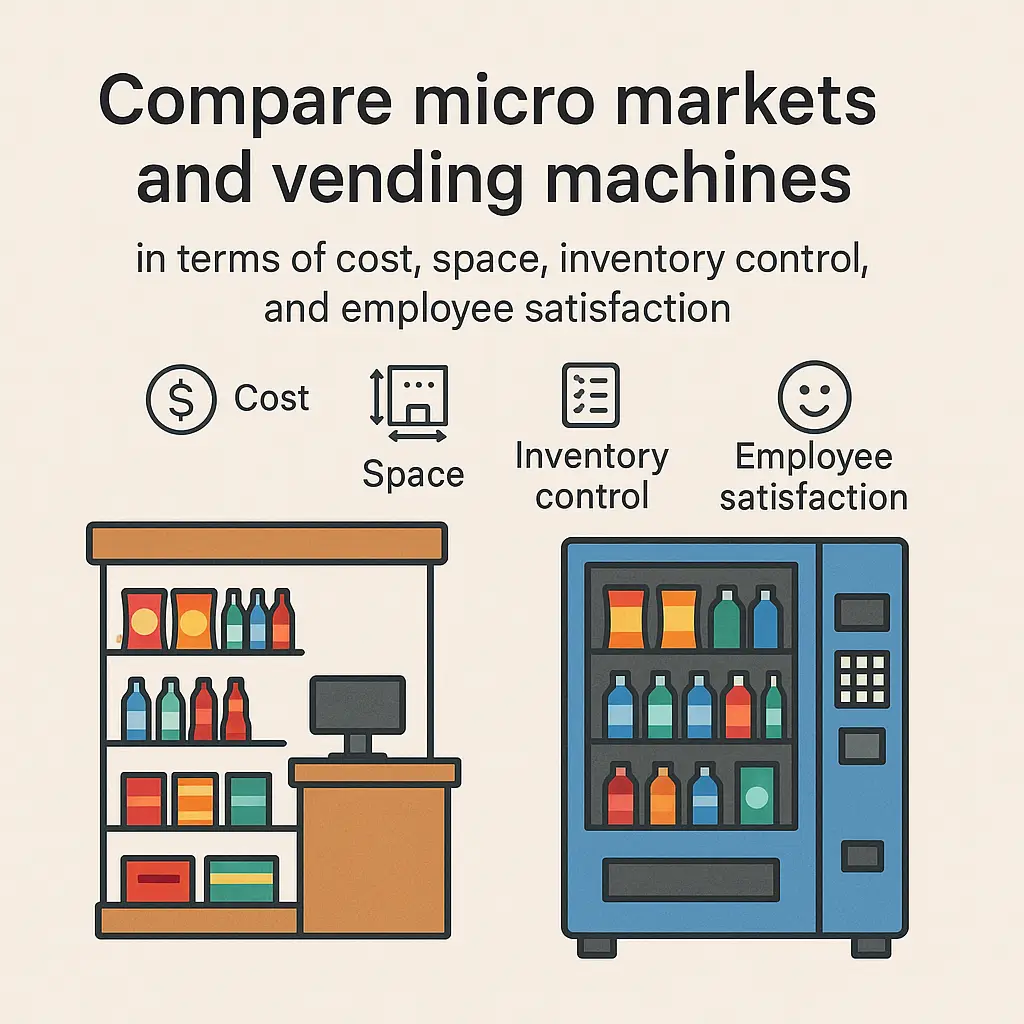Micro Markets vs Vending in Manufacturing
Compare micro markets and vending machines in terms of cost, space, inventory control, and employee satisfaction.
Back to Vending for Manufacturing ResourcesCompare micro markets and vending machines in terms of cost, space, inventory control, and employee satisfaction.
Back to Vending for Manufacturing ResourcesMicro markets can serve large shift teams better, offering more food and drink choices with self-checkout kiosks. However, vending machines work well in areas with limited space or fewer employees. Learn what makes the most sense by exploring key differences.
![]() Micro markets offer broader product variety than vending machines
Micro markets offer broader product variety than vending machines
![]() Smart systems improve inventory tracking and minimize stockouts
Smart systems improve inventory tracking and minimize stockouts
![]() Contactless payments help boost employee convenience in break rooms
Contactless payments help boost employee convenience in break rooms

Manufacturing facilities often face unique break room challenges—from limited space and shift-based schedules to employee preferences for quick, reliable service. When deciding between micro markets and vending machines, it's important to weigh several key factors including product variety, equipment footprint, payment systems, and user experience.
Product variety: Micro markets offer an expanded range of food and beverage choices, including fresh meals, salads, shelf-stable items, and even health-conscious options. This is especially useful for large facilities where employees work long or staggered shifts. Traditional vending machines have limited capacity, primarily offering snacks and drinks.
Inventory control: Micro markets use smart kiosks and shelf sensors for real-time inventory tracking. This minimizes stockouts and helps vendors tailor product selection based on usage data. Vending machines, while modern options include telemetry features, can be slower to refill and track sales in detail.
Space and setup: Vending machines are compact and ideal for tight break rooms or where foot traffic is lower. Micro markets require more space to set up open shelving, coolers, and self-checkout stations, making them better suited for larger manufacturing campuses or centralized employee lounges.
Payment systems: Micro markets support a wide range of cashless and contactless payments, including mobile wallets and employee accounts. While many vending machines also offer contactless payment, some outdated equipment in factories still relies on coins or bills, leading to unnecessary frustration for employees.
User satisfaction: Employees often prefer the shopping experience and broader selections that micro markets provide. In environments where retaining happy, productive staff is crucial, the added convenience of a micro market can make a noticeable difference.
Still comparing options? See this detailed side-by-side guide to micro markets and vending machines. For advanced solutions, explore how smart vending technologies are transforming employee break areas.
If you're exploring vending options for your business, Vending Exchange can help simplify the process. Delivery, Installation and Equipment is provided at no cost to you - vendors provide the machines, keep them stocked, and handle all servicing. Whether you need a provider or full-service management, just fill out the form on this page to get started.
Vending machines are compact and dispense pre-packaged items, while micro markets offer a wider selection of food and drinks through self-service kiosks in open shelving and coolers.
Generally, yes. Micro markets typically require more space, shelving, and technology, though installation is often covered by local vendors at no charge to qualified locations.
Micro markets use smart tracking systems that offer detailed item-level inventory management, giving vendors and facility managers better control and faster restocking.
They can be, but they’re typically best for larger staff counts with enough space. Smaller sites may benefit more from updated combo vending machines with touchless payment.
Employees appreciate freshness, variety, and ease of use. Micro markets tend to score higher in satisfaction due to their convenience and range of products.
Most support credit/debit cards, mobile wallets like Apple Pay, and employee accounts. These options are faster and more reliable than cash-based machines.
Yes. With real-time usage data, vendors can avoid overstocking and adjust inventory based on actual demand, reducing expired or unsold items.
Yes. Many modern vending machines and micro markets now support fully contactless transactions through mobile apps or smart card readers.
Both can be hygienic when maintained properly, but touchless options like self-checkout kiosks and mobile pay in micro markets may offer added sanitation benefits.
In most cases, setup can be completed within 7 days if the facility qualifies for vendor service.